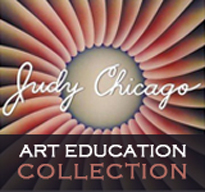Relationship of the Participatory Art Pedagogy to Other Art Teaching Approaches
The art teaching approaches experienced previously by the 70 participants and 8 facilitators in The Envisioning the Future project are typical of the range of adult art education. The participants ranged in age from 25 to 78 years and also differed in cultural backgrounds.
A few were either self-taught or learned through apprenticeship situations. Most had earned undergraduate or graduate degrees in art, or had taken some university studio courses. Self-taught approaches were also commonly used by those in university art programs that were “experimental, liberal, and encouraged exploration.” These participants learned from reading about and looking at art and from attending presentations by visiting artists.
Some participants described very hierarchical situations in which the students were “expected to kneel at the master teacher’s feet who adamantly opposed feminist and conceptual art.” Or the teacher discussed the work rather than asking students to discuss their goals in the work. Several mentioned teaching approaches in which students were told what to do and how to do it.
Many described that their art education consisted of emphasis “on technique without reference to subject” or requests for the student to use specific media and subject matter such as drawing from the nude without specifying the context or concern for what the work communicated.
Others noted that self-expression was not encouraged; yet some were encouraged to create from their interests and passions. The typical teaching approach in studio courses involved teacher demonstrations of techniques and faculty critiques to the whole class about the visual form of each student’s work. The critiques emphasized color theory and composition.
Other teaching approaches experienced included emphasis on concept development, class-wide collaborations, or students were required to create several works based on a single theme.
The Chicago/Woodman methodology is an entirely different model. “It’s a model where the teacher helps to first make each student feel valued. By listening to what the students have to say, communicates the fact that what the students have to say is important. And that their experience is worthy of examination. And next, that in their experience is potential content for artmaking, which also makes their experience important. If you can turn your experience into artmaking, then it validates your experience. It really is a very simple process, but sometimes implementing the process is not so simple. It has to do with going around in a circle, giving everybody a time and space.
The expectation for excellence is communicated in a number of ways; urging the participants to become informed on the subject in which they are interested, learning about previous work on the subject, and through what might be described as a feminist version of the Socratic method, e.g., probing, questioning, and asking the participant to think more deeply about their intentions. Also, by doing research that forces the students to actually look at a level of accomplishment, a bar is established, which helps to raise the level as well as the expectations of excellence. At the same time as they are being supported there is also the insistence that they aspire to excellence” (Judy Chicago, 11/23/2002, interview).
Read more:
1/ Overview
2/ Chicago/Woodman Teaching Methodology
3/ Relationship of Chicago/Woodman’s Participatory Art Pedagogy to Other Forms of Feminist Art Pedagogies
4/ Relationship of the Participatory Art Pedagogy to Other Art Teaching Approaches
5/ References & Copyrights

Leave a Reply
You must be logged in to post a comment.